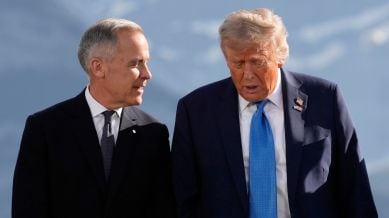Canadian PM visits Trump as relations between longtime allies sit at a low point
Mark Carney is expected to ask for relief from some of the US tariffs affecting Canadian sectors, though expectations for progress are limited.

Canadian Prime Minister Mark Carney met US President Donald Trump at the White House on Tuesday, seeking to ease tensions between the two neighbours as relations hit one of their lowest points in recent memory.
Carney’s visit comes ahead of next year’s review of the United States-Mexico-Canada Agreement (USMCA), which is central to Canada’s trade. More than three-quarters of Canada’s exports go to the US, but recent tariff disputes and Trump’s remarks about making Canada the “51st state” have strained ties.
monthly limit of free stories.
with an Express account.
“We’ve had ups and downs, but this is the lowest point in relations that I can recall,” Frank McKenna, a former Canadian ambassador to Washington and now deputy chairman of TD Bank, told the Associated Press. He said Canadians were reacting with their choices: “They are simply voting with their feet. Ordinary citizens are changing vacation plans, and business owners are shifting meetings and reward trips away from the US There is an outright rebellion.”
Carney is expected to ask for relief from some of the US tariffs affecting Canadian sectors, though expectations for progress are limited. “Improving relations with the White House ahead of the USMCA review is certainly an objective of the trip,” said Daniel Béland, a political science professor at McGill University in Montreal, speaking to the AP. “But opposition parties and part of the Canadian public will criticise Prime Minister Carney if he doesn’t achieve some progress on the tariff front.”
Trump told reporters on Monday that he expected trade to be a main topic. “I guess he’s going to ask about tariffs, because a lot of companies from Canada are moving into the United States,” Trump said after signing an executive order related to Alaska. “He’s losing a lot of companies in Canada.”
Carney has said the USMCA benefits Canada, ensuring that more than 85% of trade with the US remains tariff-free. He noted that the average US tariff on Canadian goods is 5.6%, the lowest among its trading partners.
Still, several sector-specific tariffs remain, including 50% duties on steel and aluminium under Section 232 of US trade law. McKenna said there were talks of possible relief. “It could be 50% to 25% or agreeing on tariff-free quotas to allow steel and aluminium to move at last year’s levels,” he told the AP.
The US and Canada share one of the world’s closest economic relationships. Goods and services worth about $2.5 billion (around $3.6 billion Canadian) cross their border daily. Canada is the top export destination for 36 US states and supplies most of America’s imported crude oil, electricity, steel, aluminium, and uranium.
“The bigger prize would be getting a mutual agreement to negotiate as quickly as possible the free trade relationship,” McKenna said. “If the United States were to threaten us with the six months’ notice of termination, it would create a deep chill all across North America.”